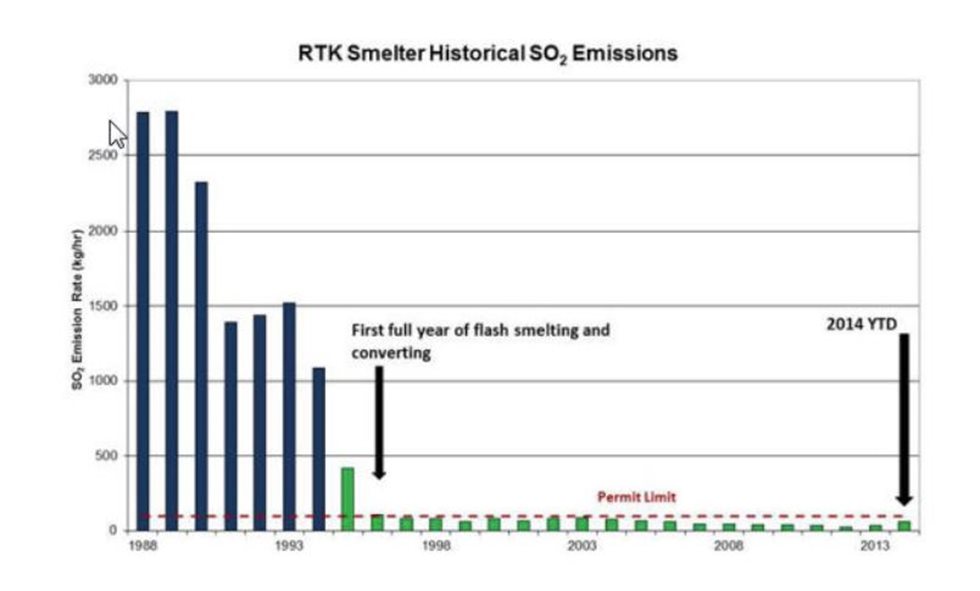FCF side-wall accretion thickness monitoring
Installation of a furnace sidewall diagnostic (PCA based) system now allows real-time magnetite side-wall thickness prediction, which brings new capability to furnace integrity monitoring for the FCF. This technology was developed by Hatch and the system improves furnace safety by providing real-time information of the sidewall accretion condition – enabling more informed operating decisions. It can also provide early detection of abnormal process measurements due to sensor failures or abnormal process drifts - adding confidence to existing methods of furnace integrity monitoring.
Remote tapping of FS matte
The RTK Smelter has historically relied on very manual intensive methods to tap matte from the FSF. It typically involved 1-2 operators at a time, use of oxygen burning lances and requiring close proximity to the working tap-hole, resulting in higher exposure to heat stress and potential for burns from molten matte. Although RTK has proven the practice to be safe over the years there has always been interest in taking the step to a more automated process, therefore reducing the workload on the operators, removing them from the direct line of fire, and decreasing exposure to off-gas and metal splash from tap-holes. There is also value from improved safety, hygiene and reduced heat stress, as well as more consistent burning and longer life of tap-hole inserts (resulting in higher furnace online times). Lewis Australia, an engineering firm specializing in automated equipment, worked with RTK engineers to develop a compact matte tapping machine. Initial trials were encouraging and two mechanized tap-hole opening and closing machines were installed during the 2014 Shutdown.
Rhenium recovery from acid plant blow-down by continuous ion exchange
RTKC smelts copper concentrate containing trace amounts of the rare metal rhenium which is associated with molybdenum in the Bingham Canyon orebody. There is a potential yield of ~ 1,000 kg/annum of recoverable rhenium. When copper concentrate is smelted the rhenium volatilizes in the flash smelting process off-gas process and is recovered in the Acid Plant Blow-down (APB). APB is treated in the Hydromet Plant along with refinery bleed solutions to recover copper while fixing bismuth and other impurities in a form suitable for discharge to tailings. Rhenium is recirculated to the smelter and can build to high levels approaching 50 mg/l (averages 20 mg/l) in the APB. Rhenium is, without a recovery plant, ultimately lost to the Hydromet Plant tails. The Smelter recently commissioned a new plant to recover Rhenium and the plant has been integrated with the existing Hydromet Plant (HMP).
Copper anode fire-refining and scrap melting using Praxair Co-Jet™ technology
The Smelter continues to improve copper scrap melting capability through application of Co-Jet technology, and in collaboration of technical developments with Praxair. The Praxair Co-Jet technology continued to add value to RTKC through increase secondary scrap treatment and flexibility to operating practice. The challenge in moving forward is to maintain this capability and flexibility while improving Anode Furnace campaign life. Additional burner development since 2012 related to burner design and flame setting control have led to positive results on maintaining the furnace refractory integrity. Additional process developments in this area, such as ‘tuyere-less’ refining, are anticipated.
Shutdown scope & execution
The longest and largest ever planned Smelter Shutdown occurred in Sept-Nov 2014, and was innovative and also critical to the future operation, and involved more than 2,000 employees and contractors. RTKC Smelter “reset” the asset health of critical, larger equipment like the FSF and concentrate dryer. The innovative FSF rebuild (which included elimination of roof refractory brick) is a unique design to manage ‘hotter’ feed at higher throughput rates and processing of lower grades of copper concentrate.
Improvements being made to the acid plant, ensuring worlds-best practice/environmental assurance around sulfur capture, as well as production assurance in sustaining throughput rates going forward. The Smelter is also working to increase the amount of time before acid plant shutdowns are required (moving from 2 years, to every 3 years).
CONCLUSIONS
The Rio Tinto Kennecott Smelter is a captive smelter and thus must respond to changes in mine and concentrator output including wide swings in concentrate production rates and grade over relatively short periods to maximize the Enterprise Value to Rio Tinto. Since the start-up of the modernized Smelter in 1995, the facility has smelted ~22.6M tonnes of dry feed to the FSF, producing ~4.6M tonnes of blister copper. Improvements to operation and control of the FCF continue to be made, particularly as relates to slag chemistry, and tap-hole insert life. Flash converting process technology is also increasingly being internationally recognized, with several new plants constructed (for instance in China) now utilizing FCF technology. The Smelter recently “reset” the asset health of critical, larger equipment such as installation of a new FSF (with new burner and air-slide systems) and a new gas-fired concentrate dryer. The innovative FSF design (which included elimination of roof refractory brick) will further enable processing of ‘hotter’ and lower grade feed at sustained higher throughput rates. The Smelter also continues to demonstrate a capacity for innovation such as a new plant to recover Rhenium from off-gas/acid streams, remote tapping of FSF matte, enhanced melting of copper scrap utilizing Co-Jet technology, and FCF sidewall accretion thickness monitoring in real-time. All of these operational practices and innovative technologies, coupled with the experience and operating know-how gained over the last 20 years, will help drive even further improvements at RTKC for the next 20 years!
